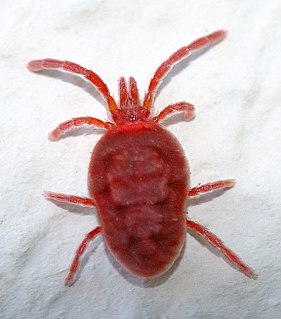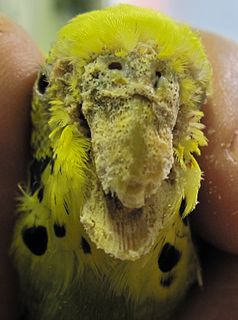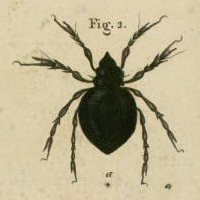Related Research Articles

Scabies is a contagious skin infestation by the mite Sarcoptes scabiei. The most common symptoms are severe itchiness and a pimple-like rash. Occasionally, tiny burrows may appear on the skin. In a first-ever infection, the infected person will usually develop symptoms within two to six weeks. During a second infection, symptoms may begin within 24 hours. These symptoms can be present across most of the body or just certain areas such as the wrists, between fingers, or along the waistline. The head may be affected, but this is typically only in young children. The itch is often worse at night. Scratching may cause skin breakdown and an additional bacterial infection in the skin.

Mites are small arachnids.

The Acari are a taxon of arachnids that contains mites and ticks. The diversity of the Acari is extraordinary and their fossil history goes back to at least the early Devonian period. Acarologists have proposed a complex set of taxonomic ranks to classify mites. In most modern treatments, the Acari are considered a subclass of the Arachnida and are composed of two or three superorders or orders: Acariformes, Parasitiformes, and Opilioacariformes; the latter is often considered a subgroup within the Parasitiformes. The monophyly of the Acari is open to debate, and the relationships of the acarines to other arachnids is not at all clear. In older treatments, the subgroups of the Acarina were placed at order rank, but as their own subdivisions have become better understood, treating them at the superorder rank is more usual.

The marsh shrew, also known as the Pacific water shrew, Bendire's water shrew, Bendire's shrew and Jesus shrew is the largest North American member of the genus Sorex. Primarily covered in dark-brown fur, it is found near aquatic habitats along the Pacific coast from southern British Columbia to northern California. With air trapped in its fur for buoyancy, marsh shrews can run for three to five seconds on top of the water. It measures about 16 cm (6.3 in) in length, including a 7-centimetre (2.8 in)-long tail, and weighs an average of 14.5–16 g (0.51–0.56 oz). The marsh shrew's diet consists mainly of invertebrates, which it hunts on land and in the water. They are rare; their populations are thought to be in decline, and they are considered endangered in parts of their range.

Varroa destructor is an external parasitic mite that attacks and feeds on the honey bees Apis cerana and Apis mellifera. The disease caused by the mites is called varroosis.

Potyviridae is a family of positive-strand RNA viruses that encompasses more than 30% of known plant viruses, many of which are of great agricultural significance. Currently, 228 species are placed in this family, divided among 12 genera with three unassigned species.

Varroa is a genus of parasitic mites associated with honey bees, placed in its own family, Varroidae. The genus was named for Marcus Terentius Varro, a Roman scholar and beekeeper. The condition of a honeybee colony being infested with Varroa mites is called varroosis.
An EPPO code, formerly known as a Bayer code, is an encoded identifier that is used by the European and Mediterranean Plant Protection Organization (EPPO), in a system designed to uniquely identify organisms – namely plants, pests and pathogens – that are important to agriculture and crop protection. EPPO codes are a core component of a database of names, both scientific and vernacular. Although originally started by the Bayer Corporation, the official list of codes is now maintained by EPPO.

Cheyletiella is a genus of mites that live on the skin surface of dogs, cats, and rabbits.

Opilioacariformes is the smallest order of mites, containing a single family, and around 10 genera. They are rare, large mites, and are widely considered primitive, as they retain six pairs of eyes, and abdominal segmentation. Opilioacariformes may be the sister group to the Parasitiformes.

Psoroptes is a genus of mites, including the agents that cause psoroptic mange.

Coumaphos is a nonvolatile, fat-soluble phosphorothioate with ectoparasiticide properties: it kills insects and mites. It is well known by a variety of brand names as a dip or wash, used on farm and domestic animals to control ticks, mites, flies and fleas.

Scaly foot, or knemidocoptiasis is a bird ailment that is common among caged birds and also affects many other bird species. It is caused by mites in the genus Knemidocoptes which burrow into the bird's flesh. The tunnels made by the mites within the skin cause dermatitis and scaly lesions. Scaly face is caused by the same mite responsible for scaly foot and other related mites cause depluming. The condition is transmitted from one bird to another by direct prolonged contact.
Karyolysus is a genus of coccidia. With the exception of K. sonomae whose vertebrate host is the yellow-legged frog, species in this genus only infect lizards of the genus Lacerta.

Rhinonyssidae is a family of mites in the order Mesostigmata.
Iris adriatica is a plant species in the genus Iris, it is also in the subgenus Iris. It is a rhizomatous perennial, from the Dalmatia region of Croatia in Europe. It has short sickle shaped leaves, small stem and flowers that vary from yellow to purple or violet. It is rarely cultivated as an ornamental plant in temperate regions.

Belba is a genus of mites belonging to family Damaeidae. The genus was established by Carl von Heyden in 1826. Notaspis corynopus was the type species. Species that are part of the genus can be found in Eurasia and North America.
Pygmephorus is a genus of large mites, in the family Pygmephoridae.
The Pygmephoridae are a family of mites, in the order Trombidiformes.
References
- 1 2 3 Smiley, R.L.; Whitaker, J.O. Jr (1979). "Mites of the genus pygmephorus" (PDF). Acta Zoologica Academiae Scientiarum Hungaricae. XXV 3-4 (25): 383–408. Archived from the original (PDF) on 20 March 2017. Retrieved 19 March 2017.